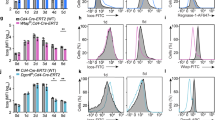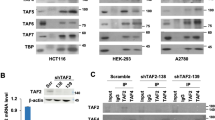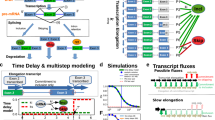ABSTRACT
RMP was reported to regulate transcription via competing with HBx to bind the general transcription factor IIB (TFIIB) and interacting with RPB5 subunit of RNA polymerase II as a corepressor of transcription regulator. However, our present research uncovered that RMP also regulates the transcription through interaction with the general transcription factors IIF (TFIIF), which assemble in the preinitiation complex and function in both transcription initiation and elongation. With in vitro pull-down assay and Far-Western analysis, we demonstrated that RMP could bind with bacterially expressed recombinant RAP30 and RAP74 of TFIIF subunits. In the immunoprecipitation assay in COS1 cells cotransfected with FLAG-tagged RMP or its mutants, GST-fused RAP30 and RAP74 were co-immunoprecipitated with RMP in approximately equal molar ratio, which suggests that RAP30 and RAP74 interact with RMP as a TFIIF complex. Interestingly both RAP30 and RAP74 interact with the same domain (D5) of the C-terminal RMP of 118-amino-acid residuals which overlaps with its TFIIB-binding domain. Internal deletion of D5 region of RMP abolished its binding ability with both subunits of TFIIF, while D5 domain alone was sufficient to interact with TFIIF subunits. The result of luciferase assay showed that overexpression of RMP, but not the mutant RMP lacking D5 region, suppressed the transcription activated by Gal-VP16, suggesting that interaction with TFIIF is required for RMP to suppress the activated transcription. The interaction between RMP and TFIIF may be an additional passway for RMP to regulate the transcription, or alternatively TFIIF may cooperate with RPB5 and TFIIB for the corepressor function of RMP.
Similar content being viewed by others
Log in or create a free account to read this content
Gain free access to this article, as well as selected content from this journal and more on nature.com
or
Abbreviations
- pol I, II, and III:
-
RNA polymerase I, II, and III, respectively
- TF:
-
transcription factor
- HBx:
-
hepatitis B virus X protein
- RPB:
-
RNA polymerase II subunit
- GST:
-
glutathione S-transferase
- PAGE:
-
polyacrylamide gel electrophoresis
- RMP:
-
RPB5-mediating protein
- PCR:
-
polymerase chain reaction
References
Schlegel BP, Green VJ, Ladias JA, Parvin JD . BRCA1 interaction with RNA polymerase II reveals a role for hRPB2 and hRPB10alpha in activated transcription. Proc Natl Acad Sci USA 2000; 97:3148–53.Tan
Q, Linask KL, Ebright RH, Woychik NA . Activation mutants in yeast RNA polymerase II subunit RPB3 provide evidence for a structurally conserved surface required for activation in eukaryotes and bacteria. Genes Dev 2000; 14:339–48.
Koleske AJ, Young RA . An RNA polymerase II holoenzyme responsive to activators. Nature 1994; 368:466–9.
Murakami S . Hepatitis B virus X protein: structure, function and biology. Intervirology 1999; 42:81–99.
Cheong JH, Yi M, Lin Y, Murakami S . Human RPB5, a subunit shared by eukaryotic nuclear RNA polymerases, binds human hepatitis B virus X protein and may play a role in X transactivation. Embo J 1995; 14:143–50.
Dorjsuren D, Lin Y, Wei W, Yamashita T, Nomura T, Hayashi N, Murakami S . RMP, a novel RNA polymerase II subunit 5-interacting protein, counteracts transactivation by hepatitis B virus X protein. Mol Cell Biol 1998; 18:7546–55.
Yang Y, Zheng L, Chen Y . [Study of HBV X protein and RMP, an RPB5 mediate protein competitively interacting with general transcription factor TF2B]. Zhonghua Gan Zang Bing Za Zhi 2000; 8:15–7.
Lin Y, Tang H, Nomura T, Dorjsuren D, Hayashi N, Wei W, Ohta T, Roeder R, Murakami, S . The hepatitis B virus X protein is a co-activator of activated transcription that modulates the transcription machinery and distal binding activators. J Biol Chem 1998; 273:27097–103.
Lin Y, Nomura T, Cheong J, Dorjsuren D, Iida K, Murakami S . Hepatitis B virus X protein is a transcriptional modulator that communicates with transcription factor IIB and the RNA polymerase II subunit 5. J Biol Chem 1997; 272:7132–9.
Miyao T, Woychik NA . RNA polymerase subunit RPB5 plays a role in transcriptional activation. Proc Natl Acad Sci USA 1998; 95:15281–6.
Roeder RG . The role of general initiation factors in transcription by RNA polymerase II. Trends Biochem Sci 1996; 21:327–35.
Garrett KP, Serizawa H, Hanley JP, Bradsher JN, Tsuboi A, Arai N, Yokota T, Arai K, Conaway RC, Conaway JW . The carboxyl terminus of RAP30 is similar in sequence to region 4 of bacterial sigma factors and is required for function. J Biol Chem 1992; 267:23942–9.
Sopta M, Burton ZF, Greenblatt J . Structure and associated DNA-helicase activity of a general transcription initiation factor that binds to RNA polymerase II. Nature 1989; 341:410–4.
Wei W, Dorjsuren D, Lin Y, Qin W, Nomura T, Hayashi N, Murakami S . Direct interaction between the subunit RAP30 of transcription factor IIF (TFIIF) and RNA polymerase subunit 5, which contributes to the association between TFIIF and RNA polymerase II. J Biol Chem 2001; 276:12266–73.
Nikolov DB, Burley SK . RNA polymerase II transcription initiation: a structural view. Proc Natl Acad Sci USA 1997; 94:15–22.
Sopta M, Carthew RW, Greenblatt, J . Isolation of three proteins that bind to mammalian RNA polymerase II. J Biol Chem 1985; 260:10353–60.
Conaway JW, Conaway RC . A multisubunit transcription factor essential for accurate initiation by RNA polymerase II. J Biol Chem 1989; 264:2357–62.
Flores O, Ha I, Reinberg D . Factors involved in specific transcription by mammalian RNA polymerase II. Purification and subunit composition of transcription factor IIF. J Biol Chem 1990; 265:5629–34.
Kim J B, Yamaguchi Y, Wada T, Handa H, Sharp PA . Tat-SF1 protein associates with RAP30 and human SPT5 proteins. Mol Cell Biol 1999; 19 :5960–8.
Lipinski KS, Esche H, Brockmann D . Amino acids 1-29 of the adenovirus serotypes 12 and 2 E1A proteins interact with rap30 (TF(II)F) and TBP in vitro. Virus Res 1998; 54:99–106.
McEwan IJ, Gustafsson J . Interaction of the human androgen receptor transactivation function with the general transcription factor TFIIF. Proc Natl Acad Sci USA 1997; 94:8485–90.
Tan S, Aso T, Conaway RC, Conaway JW . Roles for both the RAP30 and RAP74 subunits of transcription factor IIF in transcription initiation and elongation by RNA polymerase II. J Biol Chem 1994; 269:25684–91.
McCracken S, Greenblatt J . Related RNA polymerase-binding regions in human RAP30/74 and Escherichia coli sigma 70. Science 1991; 253:900–2.
Tan S, Conaway RC, Conaway JW . Dissection of transcription factor TFIIF functional domains required for initiation and elongation. Proc Natl Acad Sci USA 1995; 92:6042–6.
Flores O, Lu H, Killeen M, Greenblatt J, Burton ZF, Reinberg D . The small subunit of transcription factor IIF recruits RNA polymerase II into the preinitiation complex. Proc Natl Acad Sci USA 1991; 88:9999–10003.
Killeen M, Coulombe B, Greenblatt J . Recombinant TBP, transcription factor IIB, and RAP30 are sufficient for promoter recognition by mammalian RNA polymerase II. J Biol Chem 1992; 267:9463–6.
Killeen MT, Greenblatt JF . The general transcription factor RAP30 binds to RNA polymerase II and prevents it from binding nonspecifically to DNA. Mol Cell Biol 1992; 12:30–7.
Joliot V, Demma M, Prywes R . Interaction with RAP74 subunit of TFIIF is required for transcriptional activation by serum response factor. Nature 1995; 373:632–5.
Zhu H, Joliot V, Prywes R . Role of transcription factor TFIIF in serum response factor-activated transcription. J Biol Chem 1994; 269:3489–97.
Murakami S, Cheong J, Ohno S, Matsushima K, Kaneko S . Transactivation of human hepatitis B virus X protein, HBx, operates through a mechanism distinct from protein kinase C and okadaic acid activation pathways. Virology 1994; 199:243–6.
McKune K, Woychik NA . Functional substitution of an essential yeast RNA polymerase subunit by a highly conserved mammalian counterpart. Mol Cell Biol 1994; 14:4155–9.
McKune K, Moore PA, Hull MW, Woychik NA . Six human RNA polymerase subunits functionally substitute for their yeast counterparts. Mol Cell Biol 1995; 15:6895–900.
Todone F, Weinzierl RO, Brick P, Onesti S . Crystal structure of RPB5, a universal eukaryotic RNA polymerase subunit and transcription factor interaction target. Proc Natl Acad Sci USA 2000; 97:6306–10.
Cramer P, Bushnell DA, Fu J, Gnatt AL, Maier-Davis B, Thompson NE, Burgess RR, Edwards AM, David PR, Kornberg RD . Architecture of RNA polymerase II and implications for the transcription mechanism. Science 2000; 288:640–9.
Maldonado E, Drapkin R, Reinberg D . Purification of human RNA polymerase II and general transcription factors. Methods Enzymol 1996; 274:72–100
Acknowledgements
We thank Dr. RG Roeder for the plasmids of His-pET-RAP74 and pGST-RAP30. We are grateful to Dr. Y. Hirose for the plasmids of pFRu-luc and pRu-luc; and to F. Momoshima, M. Yasukawa, and K. Kuwabara for technical assistance. We also thank Dr. E Sun for encouraging discussion.
This work was partly supported by National Natural Science Foundation of China (Grant 30140007).
Author information
Authors and Affiliations
Corresponding author
Rights and permissions
About this article
Cite this article
WEI, W., GU, J., ZHU, C. et al. Interaction with general transcription factor IIF (TFIIF) is required for the suppression of activated transcription by RPB5-mediating protein (RMP). Cell Res 13, 111–120 (2003). https://doi.org/10.1038/sj.cr.7290155
Issue date:
DOI: https://doi.org/10.1038/sj.cr.7290155
Keywords
This article is cited by
-
General Transcription Factor IIB Overexpression and a Potential Link to Proliferation in Human Hepatocellular Carcinoma
Pathology & Oncology Research (2013)
-
Comprehensive analysis of 19q12 amplicon in human gastric cancers
Modern Pathology (2006)



